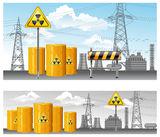Political Split Bigger Than Scientific Fissures Over Nuclear Waste Home

Resolving the issue of long-term nuclear waste
storage seems impermeable. Yucca Mountain is alive,
but barely. Other ideas are plausible, but remote.
Right now, used nuclear fuel rods are cooled in
pools for up to five years before they are stored in
above-ground concrete-encased barrels. That was to
be a temporary solution until a permanent storage
site was found. Yucca Mountain was picked in 1987
and $12 billion later, engineers have been unable to
prove that water would not leach into the burial
site. That has forced designers to keep developing
new barriers that have made the project
cost-prohibitive.
But better options may exist. Consider: the U.S.
Department of Energy’s
Waste Isolation Pilot Program (WIPP), a massive
salt formation in southeastern New Mexico that has
been accepting waste from nuclear weapons for 14
years. But it is not permitted to take in low-level
spent fuel from commercial nuclear reactors.
“WIPP already has the logistics solved, is
environmentally safer, faster and cheaper than any
alternative, has the infrastructure and workforce
already in place, and has regional community
acceptance of about 90 percent, says Jim Conca,
director of the Center for Laboratory Sciences for
RJLee Group. “There would have to be changes
made to various laws, statutes, permits and
agreements, but those would be much easier and
faster than either resurrecting Yucca Mountain or
starting from scratch to find a third location.”
Salt formations are better repositories than the
hard rock at Yucca Mountain, he adds. Rocks can
fracture. Salt does not. And the best such salt
formations are in New Mexico and Texas. As for WIPP:
It is 16 square miles of a 10,000-square mile,
2,000-foot thick salt layer, which is the tightest
rock on earth.
Still, obstacles abound: Administrative changes are
necessary to allow the transport and disposal of
spent fuel from the current interim sites to WIPP.
And, political resistance is also omnipresent.
Moreover:
“Many scientists for decades have considered salt to
have serious deficiencies in comparison to some
other geologic formations ... because such
heat-generating waste can rapidly deform salt and
create instability that could endanger workers and
release radioactivity,” says the
Southwest Research and Information Center in New
Mexico. “In addition, the WIPP site is surrounded by
active oil and natural gas production facilities and
reserves underlie the waste disposal area, which can
result in breaches and releases of radioactivity.”
About 70,000 tons of nuclear waste is now present in
30 states. Illinois, New York State, Pennsylvania
and South Carolina are the biggest hosts. Reactors,
meanwhile, are generating about 2,000 additional
tons a year.
Legally Alive
The D.C. Court of Appeals ruled in a 2-to-1 decision
earlier this year that the Nuclear Regulatory
Commission must follow the law and continue its
analysis into whether Yucca Mountain would be a safe
permanent repository. Legally, the project is alive
but politically, it stands little chance of becoming
permanent repository, especially because the Senate
Majority Leader opposes the deal and he represents
Nevada.
Meantime, Canada is in the midst of making a choice
that could affect millions of Americans.
Ontario Power Generation wants to store its used
nuclear material near Lake Huron’s shorelines. A
panel there will issue its finding so that the
Canadian government can decide whether it would
proceed. The facility would be more than 2,200 feet
below the earth in a layer of limestone, reports the
Detroit Free Press.
The paper says that Canadian residents favor the
long-range disposal site over the current interim
storage sites. But it is the American side that
opposes it, largely because residents and commercial
operators fear that such a project would severely
disrupt their lives.
But the general debate over disposal of spent
nuclear fuel has infused other compelling ideas,
namely reprocessing: It separates the uranium and
the plutonium from the rest of the nuclear waste,
allowing plant operators to get between 20 percent
and 30 percent more use from the uranium. The
concern is that some of the materials could be
re-used to make nuclear weapons.
However, Electricite de France and Areva reprocess
irradiated fuel and about
17 percent of France’s electricity is recycled
from such nuclear waste. Kansai Electric Power Co.
in Japan, meanwhile, uses reprocessed nuclear fuel
from France. Both countries mix uranium and
plutonium, or MOX. That is an alternative to
low-enriched uranium.
“The need for a new strategy is urgent, not just to
address these damages and costs but because this
generation has a fundamental, ethical obligation to
avoid burdening future generations with the entire
task of finding a safe, permanent solution for
managing hazardous nuclear materials they had no
part in creating,” says the
Blue Ribbon Commission on America’s Nuclear Future
formed in 2010.
The political divide, though, is bigger than the
scientific split. Until those sentiments are
addressed, nuclear waste won’t leave its current
home.
Twitter: @Ken_Silverstein
Copyright © 1996-2013 by CyberTech, Inc. All rights reserved.
To subscribe or visit go to: http://www.energycentral.com
To subscribe or visit go to: http://www.energybiz.com
http://www.energybiz.com/article/13/10/political-split-bigger-scientific-fissures-over-nuclear-waste-home